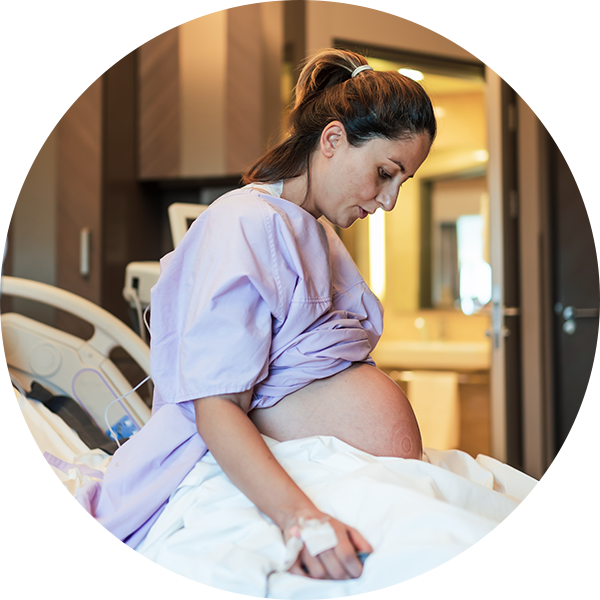
Anesthesia Services

PAIN RELIEF FOR CHILDBIRTH
Good pain relief during labor and delivery enables you to be more comfortable and to more effectively participate in the birth of your baby. The degree of discomfort experienced during labor and delivery varies from patient to patient and from one labor experience to the next. Some women do very well with techniques such as Lamaze, while most request further assistance and thereby use a combination of techniques. Depending upon your labor pattern, labor progress, medical history and your baby’s condition, additional pain management might include intravenous (I.V.) medications or epidural analgesia. The vast majority of women in labor prefer to have epidural analgesia because of the excellent pain relief it provides without sedation. Epidural analgesia has a long history of safety for both mother and baby. Remember, the choice of analgesia is a decision reached by you and your health care team (anesthesiologist, nurse anesthetist, obstetrician, nurse).
EPIDURAL ANALGESIA
The epidural space runs the length of your back and is located just outside the sac that contains the spinal cord, nerves, and spinal fluid. A tiny catheter placed in the epidural space in the small of your back (the lumbar region) allows the administration of pain control medications after Surgery. Epidural analgesia is often more effective than other forms of pain management following certain types of procedures, and your anesthesiologist will explain this method more thoroughly if it is indicated.
Potential Risks of Epidural Analgesia/Anesthesia
We are very proud of our excellent obstetrical anesthesia track record of safety and concern for mother and baby. Though serious side effects occur infrequently, we are fully prepared to handle any situation. It is important to note that in almost every situation, the advantages of pain relief during childbirth greatly outweigh the potential risks. A catheter bumping against a nerve can cause a brief “funny bone” sensation, but nerve injury related to an epidural is exceedingly rare. Most patients have a backache after childbirth, whether or not they have had an epidural. Sometimes, patients will have “breakthrough pain” and will require an additional dose of medications or, occasionally, the epidural might need to be replaced. Communicating with your care provider is very important in obtaining the most responsive pain management. Other very uncommon events might involve some medication entering a blood vessel or the spinal fluid sac. If the epidural needle or catheter enters the spinal fluid sac, the patient might get a headache, 24 to 48 hours later. We have effective treatments for this problem.
ANESTHESIA FOR CESAREAN SECTION
There are two types of anesthesia used for Cesarean sections: regional or general anesthesia. A recommendation will be made by the anesthesiologist after a review is made of you and your baby’s medical condition. Both methods of anesthesia have a long history in obstetrics and although there are risks, they have been shown to be safe for you and your baby.
Regional Anesthesia
Regional anesthesia is an attractive choice because you can be awake during your baby’s birth and your support person can join you in the operating room. Also, your baby’s exposure to medications is reduced and the potential risks of general anesthesia can be avoided. Regional anesthesia is administered using one of two techniques: epidural or spinal anesthesia. If you already have an epidural catheter in place from labor, stronger anesthetic medications will be given to establish anesthesia for your cesarean section. Once the epidural or spinal anesthetic becomes effective, you will be numb from your mid-chest to your toes. Your legs will seem heavy and you might not be able to move them until after the anesthetic wears off. You might feel some tugging, pulling or pressure as the baby is born, but you should not feel pain. As mentioned, an alternative to epidural anesthesia is spinal anesthesia which involves injecting a local anesthetic into the spinal fluid sac. Receiving a spinal anesthetic is very similar to receiving an epidural anesthetic, you can discuss the relative risks and benefits of spinal or epidural anesthesia for cesarean section with your anesthesia provider. Both provide excellent anesthesia for your c-section.
General Anesthesia
Occasionally it is necessary to use general anesthesia. To minimize your baby’s exposure to anesthetic agents, your abdomen will be cleansed and draped before you go to sleep. Medication will be injected through your I.V. to induce general anesthesia. After you are asleep, a special breathing tube will be placed into your mouth to reduce the risk of aspiration of stomach contents. Care is taken to try to guard against damage to your teeth and lips. After the tube is in place, the Surgery begins. After the Surgery is completed, the breathing tube will be removed and you will be transferred to the recovery room for observation. A sore throat post-operatively is an occasional complaint.
POST CESAREAN SECTION PAIN MANAGEMENT
Atlantic Anesthesia’s Post-operative Pain Management Service offers personalized options techniques for post c-section pain management. These include options for allowing you to use computerized patient-controlled relief systems.
Most often, narcotics (Duramorph, Astramorph) are given painlessly via the epidural catheter or with a spinal anesthetic. One dose can provide pain relief for 12 to 24 hours. Patients are frequently out of bed and walking the same day as their Surgery. The pain relief tends to be constant, thereby avoiding the peaks and valleys that are associated with traditional “shots.” PCA (Patient Controlled Analgesia) uses a pump filled with pain medication which is connected to your I.V. bag allowing you to push a button and receive a safe dose of your medication. An advantage of PCA is that you control the timing of your pain medication. The safety features allow only a single dose within a specific time period no matter how many times the button is pushed. As with any narcotic, occasional side effects might occur including itching, nausea and, very rarely, slowing of your breathing. These are usually mild and easily managed. No narcotic given by any route totally eliminates pain, but Epidural/Spinal Narcotics and PCA are usually far more effective than “shots” in decreasing post c-section pain to a tolerable level. Both methods are safe for your baby if you are breastfeeding.


